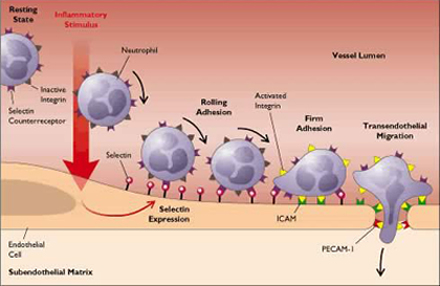Leukocyte Adhesion Deficiency
What is L.A.D?
Updated 05/05/06Leukocyte Adhesion Deficiency is an extremely rare (less than 300 cases worldwide), inherited immunity disorder that is caused by a defect on Chromosome 21.
Essentially this defect affects the ability of the patient's White Blood Cells (or Leukocytes) from finding the site of an infection and then adhering to that site so that antibodies can be released to fight the infection.
There are 2 types of LAD: Type I and Type II.
Type I:
Symptoms of LAD I are late separation of the umbilical chord in babies, slow healing of wounds and susceptibility to bacterialogical and fungal infections.
Type II:
Symptoms of LAD II are recurrent infections, malformed or misshapen features, the Bombay blood phenotype and severe growth and psychomotor retardation. This is extremely rare with only a handful of reported cases.
Diagram
The diagram below depicts the normal action of neutrophils.

Upon infection the epithelial cells become inflamed and secrete Selectins. The neutrophil (a constituent of the blood) reponds to the appearance of Selectins and migrates towards the site of the infection. Upon contact Integrins are activated and these then adhere to corresponding molecules on the surface of the affected tissue to create a so-called Inter-Cellular Adhesion Molecule (or ICAM). The neutrophil then penetrates into the affected tissue and discharges its antibacterial payload to fight the infection.
In LAD the neutrophils are not able to find the site of the infection and the body is thus not able to fend off bacterialogical and fungal infections.
What this means is that those who are caring for sufferers of LAD must adopt an aggressive management regime. In other words parents have to be extremely vigilant in respect of risk to baterial infection. We scan Roxy every day (often more than once) for signs of infection and we have adopted a careful routine for washing our hands and cleansing them with antibacterial hand washes every time we pick her up. We've had a couple of scares already (see Roxy's Progress Weblogfor more) but so far we have been very well cared for and Roxy is healthy.